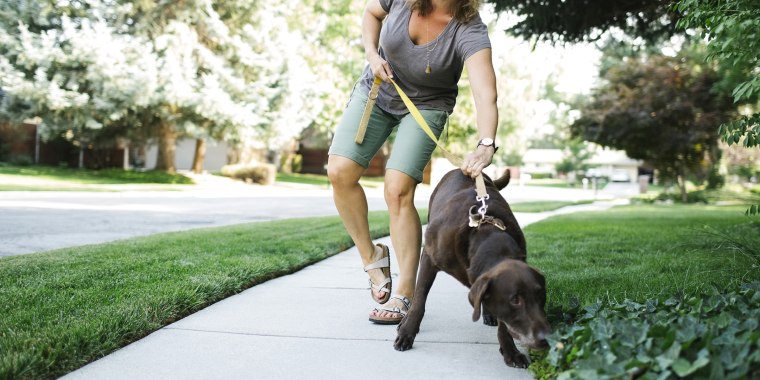Dog Owners' Broken Wrists, Elbows and Fractured Hips
"Dog walker's elbow is an unofficial name given to epicondytitis of the elbow. It was first described in 1981 by an American doctor who noticed the symptoms when walking his dog. The cause is thought to be from overloading the tendon attachments at the elbow from persistent repetitive gripping to control the leash."
"There are some harnesses properly designed to have points to attach the lead, either front-of-chest and on the back. I use the back fastening for long lines in the park, and the front one to teach lovely loose-lead walking."
"In some early cases, anti-inflammatory medication may help. Physiotherapy is the best first-line treatment and in cases like dog walkers, where they may not be able to avoid the competitive loading, a tennis-elbow splint might help."
"This [tennis-elbow split] is an activity splint that should not be used at rest and needs to be properly positioned to be effective. If pain is persisting despite these remedies, patients should seek medical advice and an elbow surgeon can assess and investigate as necessary to make sure nothing else sinister is going on in the elbow."
Dr. Nick Ferran, consultant trauma and orthopedic surgeon, The Lister Hospital, London
 |
Women, particularly older women, are increasingly showing up at hospital emergency rooms with injuries resulting from dog walking. Walking their dogs. Mostly women, and mostly older women because they have more fragile bones than men their age, and lack the muscular strength of men of all ages. According to a University of Pennsylvania Medicine study published in JAMA Surgery, women over 65 are particularly at risk. Studying emergency room visits the researchers found hip fractures the most common injury followed by fractures of the wrist and upper arm.
Companion dogs, it is well known, add quality to the lives of people. And for those lacking human company, a companion dog serves to fill emotional gaps and solve an issue of loneliness. Having someone to share life with, from ordinary daily events to simply sharing intimate space with a caring creature whose intelligence serves to aid in communication, adds immense quality to life. Walking a dog is an invaluable aid to exercising in the open air, the result of which will be a healthier person and a healthy dog, both of whom can also count on weight control resulting from daily walks.
 |
Dog owners risk serious hand injuries caused by collars and leads: surgeons |
Of course it makes eminently good sense that older people, particularly women, focus on a small dog as a companion. Even small dogs are capable of exerting great muscular momentum when they pull; hugely exacerbated the larger a dog is. Dog training exercises are always recommended as a learning tool enabling an individual to teach their dog to obey commands, chief among them solving behavioural issues and dog-walking protocols.
For the elderly there are always issues such as inattention, and having a dog underfoot that can result in a fall, being inadvertently tripped, and experiencing a fall serious enough for a hip injury which in older women can end up being fatal. And then there is dog-walker's elbow, wrist or shoulder caused by repetitive strain injury, when a dog persistently pulls ahead and the walker attempts fruitlessly, to restrain the dog. It helps to know how to walk a dog on a leash, and wrapping a leash around one's wrists or hands is unhelpful, while using a retractable leash is preferential.
 |
| Dog owners are suffering injuries by holding their dogs the wrong way, as this graphic shows |
Everyone has experienced the sudden surprise of a dog leaping forward to charge ahead when a squirrel has been sighted and the dog assumes it is free to bound ahead and chase after the small animal. If someone is walking a small dog when that happens the result is the walker is surprised but firmly holding the leash, it is the dog that is even more surprised when it abruptly discovers it can go so far and no further. If it's a large dog being walked and which suddenly, unexpectedly leaps after a squirrel, it can take the walker alongside momentarily, just before slipping and thudding to the ground.
How to walk the dog safely
- Don’t wrap the leash around your hand or wrist.
- Use a retractable leash.
- Take your dog to obedience school.
- Pay attention. Don't text and walk.
Today
"We call Boyare [five-year-old 77-lb.rescue dog, part 'Staffie, part kitchen sink'] 'Yank Pullarmski'. He assumes we share his desire to eradicate the world of squirrels and cats. His eyesight is much better than ours, so the first we know is when he yanks an arm."
"I'm convinced that one arm is now several centimetres longer than the other."
"Our dog walker, disturbingly, has shoulder problems now and has just had an MRI."
Julia Leonard, food writer, culinary salon host, London
Labels: Avoiding Accidents, Dog Ownership, Health

0 Comments:
Post a Comment
<< Home